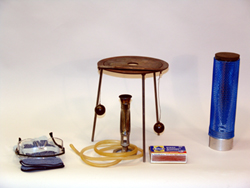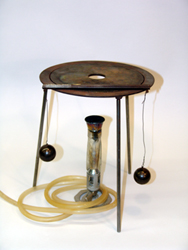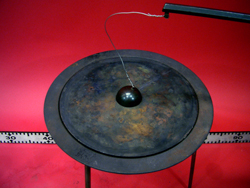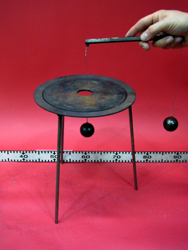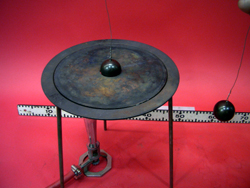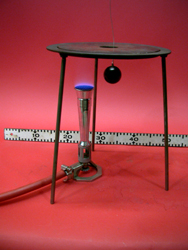|
Size: 3273
Comment:
|
← Revision 27 as of 2013-07-17 18:25:12 ⇥
Size: 5009
Comment:
|
| Deletions are marked like this. | Additions are marked like this. |
| Line 2: | Line 2: |
| ||<:30%>[:PiraScheme#Thermodynamics: Table of Thermodynamics Demonstration]||<:30%>[:TDEquipmentList: Thermodynamics Equipment List]||<:30%>[:Demonstrations:Lecture Demonstrations]|| | ||<30% style="text-align:center">[[PiraScheme#Thermodynamics|Table of Thermodynamics Demonstration]] ||<30% style="text-align:center">[[TDEquipmentList|Thermodynamics Equipment List]] ||<30% style="text-align:center">[[Demonstrations|Lecture Demonstrations]] || |
| Line 4: | Line 4: |
| = Balls and Plate , 4A30.22 = | = Balls and Plate, 4A30.22 = |
| Line 7: | Line 8: |
| Thermal Properties of Matter, [:ThermalProperties#Thermometry: 4A30. Thermometry] | Thermal Properties of Matter, [[ThermalProperties#SolidExpansion|4A30. Solid Expansion]] |
| Line 10: | Line 12: |
| * '''Cabinet:''' [:ThermoCabinet:Thermodynamics (TD)] * '''Bay:''' [:ThermoCabinetBayA3:(A3)] * '''Shelf:''' #1 |
|
| Line 14: | Line 13: |
| attachment:4A30-22_01.jpg | * '''Cabinet:''' [[ThermoCabinet|Thermodynamics (TD)]] * '''Bay:''' [[ThermoCabinetBayA3|(A3)]]? * '''Shelf:''' #1? {{attachment:4A30-22_01.jpg}} |
| Line 18: | Line 21: |
| Insert description of apparatus, its component, what it is demonstrating. | A plate with a hole is heated with a set of two balls, one over and one under size. Heat the plate and slip over both. ||<40% style="text-align:center">'''Equipment''' ||<30% style="text-align:center">'''Location''' ||<25% style="text-align:center">'''ID Number''' || || || || || ||A brass plate with a hole ||[[ThermoCabinetBayA3|TD, A3, Shelf #1]] ||<style="text-align:center">4A30.22 || ||Two metal balls attached to a rod ||[[ThermoCabinetBayA3|TD, A3, Shelf #1]] ||<style="text-align:center">4A30.22 || ||Burner ||location ||<style="text-align:center">NA || ||Liquid Nitrogen ||location ||<style="text-align:center">NA || ||Safety glove and glasses ||location ||<style="text-align:center">NA || ||[[RedWhiteGasCart|Red and white gas carts]] ||Rooms 2103, 2241, (and 2223 upon request) || || |
| Line 20: | Line 30: |
| ||<:style="width: 60%" :40%>'''Equipment'''||<:30%>'''Location'''||<:25%>'''ID Number'''|| || || || || ||A brass plate with a hole||[:ThermoCabinetBayA3: TD, A3, Shelf #1]||<:> 4A30.22 || ||Two balls||[:ThermoCabinetBayA3: TD, A3, Shelf #1]||<:> 4A30.22 || ||Burner||location||<:> NA || ||Liquid Nitrogen||location||<:> NA || ||Safety glove and glasses||location||<:>NA || |
|
| Line 28: | Line 31: |
| '''''Important Setup Notes:''''' * Make sure that one of the red & white gas cart are in placed and the gas hose is connected to the utility trench gas line. The gas cylinder that supplies the gas to utility trench gas line may or may not be connected/installed and should be inspected. |
|
| Line 31: | Line 32: |
| '''Setup and Procedure:''' 1. Make sure you have the balls with two sizes, one is over and one is under the hole size, the brass plate with hole in the middle, and the stand. 1. Have the liquid nitrogen in the holder. |
|
| Line 35: | Line 33: |
| Option A. Shrink or extended ball 1. Demonstrate to students that the smaller ball can get through the hole and the larger ball cannot. 1. Heat the smaller ball or put the larger ball in the liquid nitrogen, this will make the opposite situation from the previous. |
'''''Important Setup Notes:''''' |
| Line 39: | Line 35: |
| Option B. Extended Hole 1. Demonstrate to students that the smaller ball can get through the hole and the larger ball cannot. 1. Heat the ball by the burner until you sure that the hole get larger than before. 1. Demonstrate to students again, this time both balls should get through the hole. |
* This demonstration requires a supply of methane gas usually provided by the [[RedWhiteGasCart|red and white gas carts]] found in rooms 2103, 2241, (and 2223 upon request). * This demonstration requires a supply of liquid nitrogen. The main supply is located at the loading dock. If 12 hours notice given to lecture demo, supply will be provided. '''Setup and Procedure:''' 1. To light the burner, connect the attached gas hose to the gas out (red panel) on the [[RedWhiteGasCart|red and white gas cart]]. 1. Open the gas valve. 1. Light a match and bring it near the top of the burner. 1. The flame will ignite the gas. Adjust the flame height accordingly by adjusting the valve. Option A. Shrinking and expanding the balls 1. Show that the smaller ball can get through the hole and the larger ball cannot. 1. Heat the smaller ball with the burner and show that the smaller ball can no longer fit through the hole. 1. Soak the larger ball in the liquid nitrogen and show that the larger ball can now fit through the hole. Option B. Expanding the hole 1. Demonstrate to students that the smaller ball can get through the hole and the larger ball cannot. 1. Place the burner beneath the plate to heat it. 1. Show that both balls now fit through the hole. |
| Line 45: | Line 58: |
| * Beware of the heated plate. | * Always use the gloves and safety glasses throughout this demonstration. * Beware of the heated plate - contact with skin could cause severe burns! * Use care when working with the liquid nitrogen - prolonged contact with skin causes severe frostbite! '''Discussion:''' When the plate is heated, the dimensions of the plate increase while maintaining their relative proportions. In other words, the overall area of the plate expands along with the size of the hole while the ratio of hole area to plate area remains the same. Heating causes the molecular bonds to lengthen, which causes the material to expand. You can think about it this way: a group of people standing in a tight circle with elbows linked try to lengthen their "bonds" by moving to hold hands at arms length. They have to expand the circle by standing back everyone stands further apart. This is analogous to the molecular bonds around the hole. This is considered a 2D expansion (the plate thickness is quite thin relative to the other dimensions) and can be described by ΔA/A = α,,A,,*ΔT = α,,L,,^2^*ΔT where A is the area at temperature T,,i,,, ΔA is the change in area when the material is at temperature T,,f,,, ΔT is T,,f,, - T,,i,,, and α is the coefficient of thermal expansion which depends on the material. The expansion of the balls is also 2D since the quantity of importance is the cross sectional area. See references below for more information. || {{attachment:4A30-22_01a.jpg}} || {{attachment:4A30-22_02a.jpg}} || {{attachment:BallsPlate03-250.jpg}} || {{attachment:BallsPlate04-250.jpg}} || || {{attachment:BallsPlate05-250.jpg}} || {{attachment:BallsPlate06-250.jpg}} || {{attachment:BallsPlate07-250.jpg}} || |
| Line 48: | Line 75: |
| '''Discussion:''' When the plate is heated, it expands the hole in the middle of the plate. [The molecular bonds are lengthened, when the material expands. Try to think in this way, a group of people standing in a tight circle with elbows linked. Then they lengthen their "bonds" by moving to hold hands at arms length. They also have to expand the circle by standing back, while they all stand further apart. This is like the molecular bonds around the hole.] So the ball can get through it. You have two options to show student by following. ||attachment:4A30-22_01a.jpg||attachment:4A30-22_02a.jpg||attachment other photos||attachment other photos|| |
|
| Line 57: | Line 78: |
| * [https://www.youtube.com/user/LectureDemostrations/videos?view=1 Lecture Demonstration's Youtube Channel] | * [[https://www.youtube.com/user/LectureDemostrations/videos?view=1|Lecture Demonstration's Youtube Channel]] |
| Line 60: | Line 82: |
| * [https://en.wikipedia.org/wiki/Thermal_expansion Wikipedia - Thermal Expansion] * [http://en.wikipedia.org/wiki/Coefficient_of_thermal_expansion Wikipedia - Coefficient of Thermal Expansion] |
|
| Line 63: | Line 83: |
| * [[https://en.wikipedia.org/wiki/Thermal_expansion|Wikipedia - Thermal Expansion]] * [[http://en.wikipedia.org/wiki/Coefficient_of_thermal_expansion|Wikipedia - Coefficient of Thermal Expansion]] |
|
| Line 64: | Line 86: |
| [:Instructional:Home] | [[Instructional|Home]] |
Balls and Plate, 4A30.22
Topic and Concept:
Thermal Properties of Matter, 4A30. Solid Expansion
Location:
Cabinet: Thermodynamics (TD)
Bay: (A3)?
Shelf: #1?
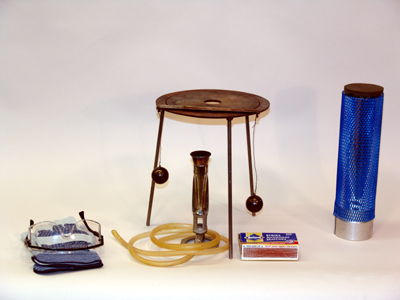
Abstract:
A plate with a hole is heated with a set of two balls, one over and one under size. Heat the plate and slip over both.
Equipment |
Location |
ID Number |
|
|
|
|
A brass plate with a hole |
4A30.22 |
|||||
Two metal balls attached to a rod |
4A30.22 |
|||||
Burner |
location |
NA |
||||
Liquid Nitrogen |
location |
NA |
||||
Safety glove and glasses |
location |
NA |
||||
Rooms 2103, 2241, (and 2223 upon request) |
|
Important Setup Notes:
This demonstration requires a supply of methane gas usually provided by the red and white gas carts found in rooms 2103, 2241, (and 2223 upon request).
- This demonstration requires a supply of liquid nitrogen. The main supply is located at the loading dock. If 12 hours notice given to lecture demo, supply will be provided.
Setup and Procedure:
To light the burner, connect the attached gas hose to the gas out (red panel) on the red and white gas cart.
- Open the gas valve.
- Light a match and bring it near the top of the burner.
- The flame will ignite the gas. Adjust the flame height accordingly by adjusting the valve.
Option A. Shrinking and expanding the balls
- Show that the smaller ball can get through the hole and the larger ball cannot.
- Heat the smaller ball with the burner and show that the smaller ball can no longer fit through the hole.
- Soak the larger ball in the liquid nitrogen and show that the larger ball can now fit through the hole.
Option B. Expanding the hole
- Demonstrate to students that the smaller ball can get through the hole and the larger ball cannot.
- Place the burner beneath the plate to heat it.
- Show that both balls now fit through the hole.
Cautions, Warnings, or Safety Concerns:
- Always use the gloves and safety glasses throughout this demonstration.
- Beware of the heated plate - contact with skin could cause severe burns!
- Use care when working with the liquid nitrogen - prolonged contact with skin causes severe frostbite!
Discussion:
When the plate is heated, the dimensions of the plate increase while maintaining their relative proportions. In other words, the overall area of the plate expands along with the size of the hole while the ratio of hole area to plate area remains the same. Heating causes the molecular bonds to lengthen, which causes the material to expand. You can think about it this way: a group of people standing in a tight circle with elbows linked try to lengthen their "bonds" by moving to hold hands at arms length. They have to expand the circle by standing back everyone stands further apart. This is analogous to the molecular bonds around the hole. This is considered a 2D expansion (the plate thickness is quite thin relative to the other dimensions) and can be described by
ΔA/A = αA*ΔT = αL2*ΔT
where A is the area at temperature Ti, ΔA is the change in area when the material is at temperature Tf, ΔT is Tf - Ti, and α is the coefficient of thermal expansion which depends on the material. The expansion of the balls is also 2D since the quantity of importance is the cross sectional area. See references below for more information.
|
|
|
|
|
|
|
Videos:
References:
